- Bernard Preston homepage
- Hummus
- Growing Chickpeas
Growing Chickpeas
This Growing Chickpeas page could be a trial for you in the first weeks as it's going to be a diary in the art of growing garbanzo beans, their other name. I have never planted them before but they are hard to get here in my native South Africa. And they are relatively expensive. So, I am going to try producing them in our large garden.
This page was last updated by Dr Bernard Preston on 10th April, 2024.
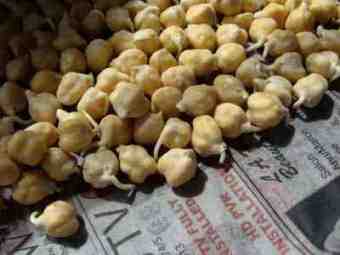
Why am I so crazy about Chickpeas? Because they belong to a group of what are known as "the superfoods" for lowering blood cholesterol. They are also rich in phytosterols.
Only a daily dip into our Quaker oats recipes is more effective in lowering cholesterol, and if refined as they probably are, they may raise your blood glucose abnormally if you are insulin resistant, as I am.
Chickpeas are also the very richest source of B6 known as pyridoxine; it is used as a vital coenzyme in over 100 chemical reactions in the body, many of them to do with glucose metabolism. Together with three other vitamins, they are known as the anti-frailty group which helps prevent this miserable affliction by a massive 260%[1].
There is much confusion and contradiction in the research in that it comes in many different forms. The two major derivatives are pyridoxine and PNG, the glucoside. The other vitameric compounds are aldehyde and amines. To add to the complexity they may also be phosphorylated.
Kant and Block found that many Americans consume significantly less than the RDA[2]. Milling extracts 75% of the vitamin which is then sold as animal feed. Much is found in the bran.
Lysine
Chickpeas are rich in an essential amino acid called lysine. It's a difficult protein for the vegetarian to get and a deficiency causes a very serious deficiency disease called kwashiorkor. It is common in Africa; anyone following a vegan weight loss program has to be careful to make sure they get adequate amounts in their diet.
I'm not a vegetarian, but I love cholesterol rich foods like butter and full cream milk, and our mutton stew recipe. And I absolutely refuse to eat margarine. Why is that? Hydrogenated foods are very bad for your nervous system.
More to the point,
cholesterol-rich food lovers like me, and all the people taking lipitor should rather be balancing their diets with high
fibre meals that lower cholesterol naturally. Chickpeas are number two of these super foods.
So I have to try my hand at growing chickpeas. Today, weather
permitting I will prepare the ground, and with luck tonight I'll have
some photos.
First I have to reclaim the land from the jungle!
Chickpeas and garbanzo beans are one and the same by the way.
SOAK THE SEED
It's imperative to soak the seed. You'll notice in the pic below that not one seed in the middle row germinated. The first row grew so readily from soaked seed, that I thought I'd try an experiment. Trust me, soak the seed! I just use the chickpeas that I buy for our authentic hummus recipe for seed.
Soak them for 24 hours, perhaps use some to make hummus, and then spread the rest on newspaper, fold it over and cover, keep damp and place on a warm window sill. Within another 24 hours the seeds will be sprouting, and ready for planting.
Meantime, shall we get on with preparing the ground? Currently we are using a minimum till method that disturbs the ground as little as possible. A tablespoon of vermi-compost from our work farms is simply worked into drill.
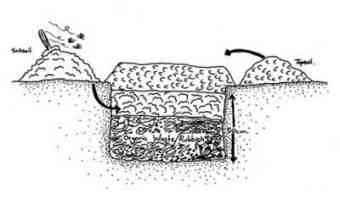
Chickpeas are heavy feeders, so I recommend you dig a trench (do your back exercises first to loosen up! It's hard work.) and fill it with compost, which is still used extensively.
Update: Rather use your kitchen waste in
making a compost pile than putting it directly into the trench. Oxygen is needed for proper degradation; anaerobically it will stink.
A crop of butternut squash from your waste may also threaten to take over your growing chickpeas as they've done in my sweet potato patch; see lower down.
Mature compost and a pail of kitchen waste ready for the compost pile.
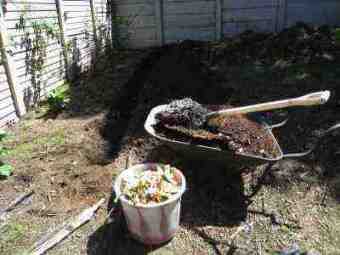
A compost heap is a must for every serious gardener; in the large garden you can compost with old mouldy sticks too, or just use a compact compost tumbler in the smaller garden.
It
uses up all that garden and kitchen waste instead of sending it to the
dump, and provides invaluable nutrients for your vegetables.
Not to be confused, these are ordinary bush beans in the foreground below.
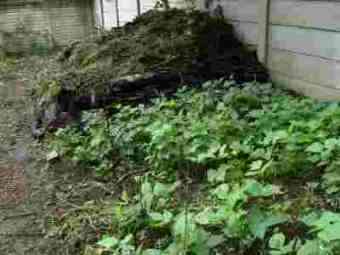
Notice the missing row in the middle in the next photo. Germinating the seed first really is a must.
Enjoy your beans and peas with butter or olive oil, by the way but never margarine, despite all the hype. Why? Our hydrogenated foods page tells all; find it using the search engine below. Read too what this eminent heart surgeon has to say about foods to reduce inflammation.
The young plants are fragile. I recommend you put a row of sticks to mark the them so you and the family don't step on them whilst negotiating the garden, and especially during weeding. They are very easily trodden underfoot.
Are you on statins with all their nasty side effects? Have you been trying to reduce the contents of your medicine cupboard since you read about iatrogenic illness? Then this foods that lower cholesterol page is for you.
Iatrogenic illness is the third most common fatal disease on the planet. Death in the main from medicines, but unnecessary surgery and hospital acquired infections too.
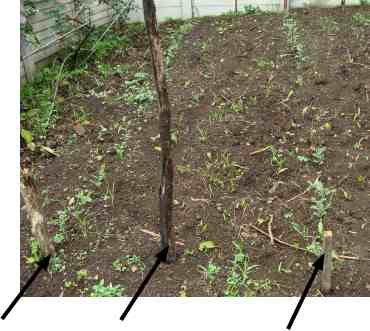
There is one red meat dish that is not reared in a sty, feeding lot, cage or fish farm which makes the animal a whole lot healthier, if you enjoy meat and legumes like I do. Sheep almost always have the run of the hills. Same as us, if their diet is healthier, not in a corn fed lot, then they make tastier and better eating food. WHAT IS MUTTON?
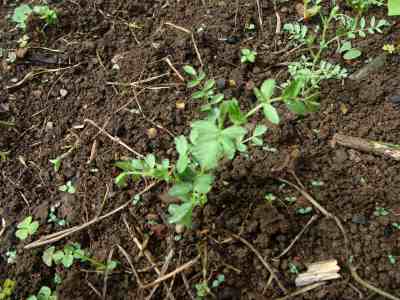
PLANT THE SPROUTED SEED @ GROWING CHICKPEAS
Cover your compost with soil that you've dug from the trench, subsoil first, topsoil at the surface. Rake it smooth and then make a shallow row with the garden fork for the sprouted chickpeas.
A mistake I made was to plant them too shallowly. Then the plants fell over when they grew larger and I had to heap the soil up. At least 1" deep is best.
Plant the seeds about 15cm apart. You can always thin them, but some won't sprout; rather a bit too thickly otherwise you'll have big gaps. At least 60 to 70cm between the rows is best, otherwise weeding becomes impossible when they are larger.
Eating and growing garbanzo beans is all about increasing the vegetable protein in your diet. There's heaps of research now showing a strong correlation between a high red meat diet and all the cancers, especially of the breast and prostate. Garbanzos are legumes which means they are rich in vegetable amino acids; the building blocks for our own protein.
Plus legumes do a wonder for your garden because only they (I think) have nitrogen fixation bacteria that add the vital inert gas nitrogen to your soil. Just look at our crop of sweet potatoes mixed with butternut that followed this chickpea crop.
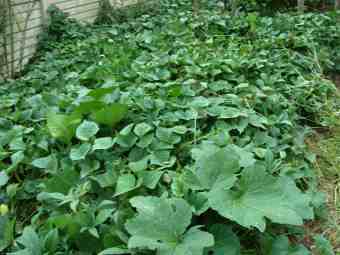
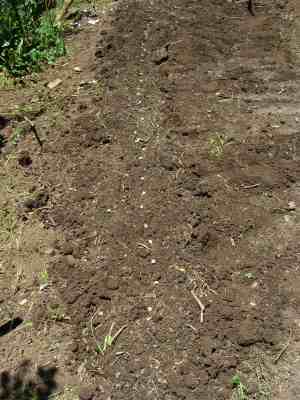
Chickpeas, I've discovered have tiny leaves compared to a conventional bushbean. They're no competition for the opposition, unable to shade out the weeds. Weeding is essential.
A aside: I used to hate weeding. Now I find it a chance to relax, mind in neutral; mind you don't pull a pea instead of a weed, not toooo relaxed! There's something very gratifying about a nicely weeded patch.
If you look carefully, you'll see where I have had to replant the second row from the left because those unsoaked seeds never sprouted. Notice the little sticks to help you mind the plants.
Growing Chickpeas
Growing chickpeas was wonderful to have done once, but not again; it was an exercise in tedium and in future I will only be using dried garbanzos. Having said that, the green fruit was wonderful.
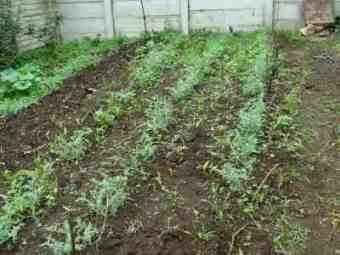
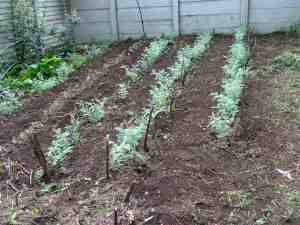
The plants are now about a foot high and I've planted another patch, about 300 plants in all. They'll be coming out of our ears! Just the best food, plenty of plant protein, full of fibre, and antioxidants, and esp for animal fat lovers like me. Eat chickpeas and you can enjoy butter and cream and eggs without guilt.
It was fun growing chickpeas, but hard work with a very small return.
If you're following a vegan weight loss diet, it is effective by the way, then it's great to include chickpeas because they are so rich in that elusive for vegetarians amino acid called lysine.
FLOWERING
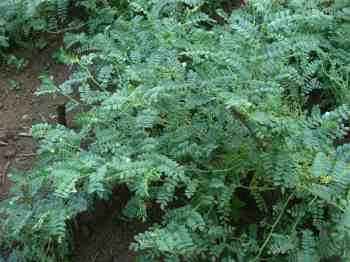
The growing chickpeas are suddenly awash with tiny white flowers, so small you can barely see them on the first photograph.
Not sure, but I think it's the hot dry spell that has brought them out, more like a Mediterranean summer climate.
The plants are quite big now as you can see. They still need weeding... a bit of a chore, but time to put the brain in neutral, never a bad thing. Sometimes I weed and think, and sometimes I just weed...!
I'm watching out for the first tiny pods, that's where the amino acid lysine and all the phytosterols are to be found.
- What are phytosterols?
Find these interesting sidelines using this search engine.
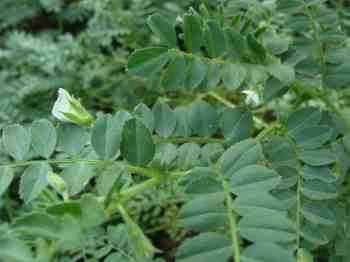
Excitement, the first growing chickpeas pods
Can you see the first pod forming? Growing chickpeas has certainly been a long wait, but my friend warned me. This is where you learn the meaning of patience is a virtue. It's now nearly two months past midsummer in the Southern Hemisphere, more than three months since planting...
Normally one thinks of chickpeas as dried food, but I'm told the green beans are absolutely scrumptious. Another few weeks... I'll keep you posted. Starting planning NOW, where you are going to plant your chickpeas in the spring. Soon, if you live in the north!
Are oats really even better than my famous authentic hummus recipe for lowering cholesterol? Yes, they are, but you have to eat a lot of oats which is tiresome. I can easily enjoy a cup of chickpeas every day, but a cup of oats? Have both. I do. That's why my cholesterol is rock bottom without statins.
- Get off statins safely
- Quaker OATS Recipes
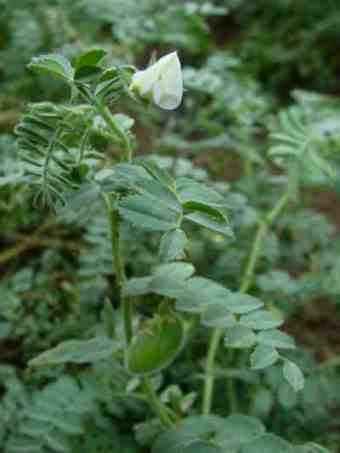
More excitement, the first chickpea
This is, as stated above, new ground for me. I've never grown chickpeas before. But I have done a good deal of reading, and finally it was time to try my hand.
Today, the first fruit. I've read that green chickpeas are definitely nicer than their dried counterpart which, if the truth be told, are rather dull without all the fruit and salad one adds.
The family think I'm weird! I put on a pot to parboil ONE chickpea! And it was absolutely delicious. Sweet like an ordinary fresh from the garden pea. Tomorrow a real picking. Fresh veg is always tastier, and I suspect healthier than dried and frozen veg.
The first chickpea, with a handful of radish nutrition. Whilst chickpeas have been quite a lot of hard work, radish must constitute the easiest salad to grow in the garden, ready to eat in 3 to 4 weeks; and I use them to spice up our hummus.
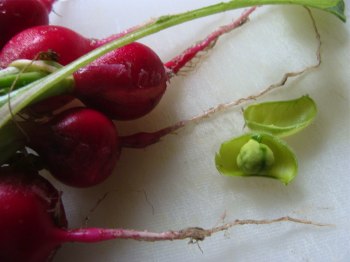
POLLINATION of growing chickpeas
I am assured that chickpeas are self pollinating, but I have seen the
odd bee visiting the flowers. I'll bet next year, once my apiary is
again established, that our yield will increase dramatically. Update: the apiary is established and we get huge crops of vegetables because of the pollination.
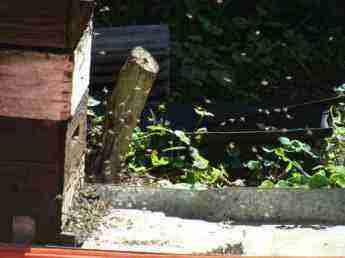
The first crop after growing chickpeas aka Garbanzo beans
First chickpeas in the pod, then the shelled peas, and finally green chickpeas, lightly parboiled. Delic...
Grandpa has a helper when it comes to podding peas of any sort, only most get eaten straight from the pod.
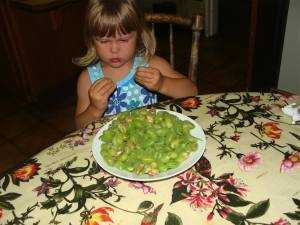
Raw chickpeas.
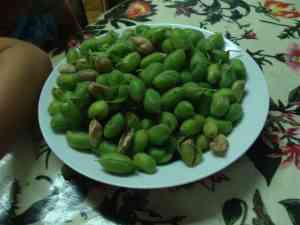
Lightly steamed fresh green chickpeas.
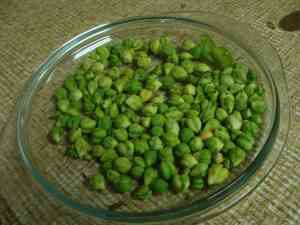
AT LAST
Yes growing chickpeas has been a long wait; over three months. This is my two-year old granddaughter who regularly visits the chickpea patch. She prefers them straight from garden; but here they are shelled and lightly cooked. The are unbelievably sweet.
I used them to make a hummus using both dried and green chickpeas.
Make our own authentic hummus recipe in only four minutes.
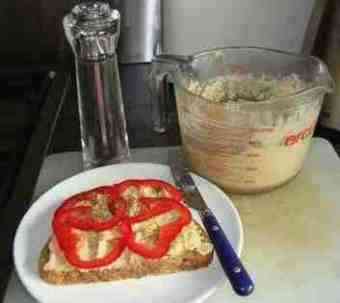
OLIVE BREAD RECIPE
Meantime if you are a really earthy person and like to bake a loaf, this is the time to start practising making our olive bread recipe. Delicious with all that hummus you'll soon have.
OLIVE BREAD RECIPE is so easy if you have the little kitchen appliance.
“Gardening is full of mistakes, almost all of them pleasant and some of them actually instructive.”
Henry Mitchell
Not unlike life, eh but some of those mistakes are often more unpleasant. Like taking a good-looking job not knowing what a horrid boss you might have.
The honest truth is that next year I'll be growing chickpeas again but only a small patch for my granddaughter. They have been a lot of hard work and on top of that, just picking these pods and shelling them, took over an hour.
Delicious and healthy though they are, with only one chickpea per pod, they need to be mechanically harvested. I'd rather put my energy into growing other legumes like pole beans that don't need to be podded.
And they obviously prefer a winter rainfall climate so, if you live in the Western Cape of South Africa, or California then give them a shot this Spring. Let me know how you get on. Plant early, once the danger of frost is over. They have a long growing season.
This is better use of your time, for my money.
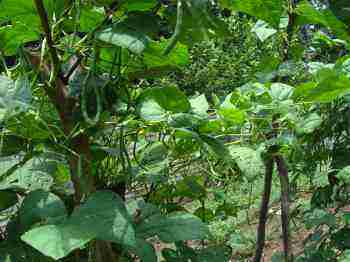 Prolific heirloom Witsa pole beans
Prolific heirloom Witsa pole beansGrowing green beans for example, especially those on a pole is a lot more rewarding.
Now that it's late summer in the southern hemisphere, it is time to get pole peas in. I used to look only for a variety that we could eat pod and all; but the Greenfeast bush variety still tastes the best.
Shelling chickpeas is not for me; but with the common Greenfeast there is no alternative.
USEFUL LINKS
When browsing use right click and "Open Link in New Tab" or you may get a bad gateway signal.
Newsletter
Our newsletter is entitled "create a cyan zone" at your home, preserving both yourself and Mother Earth for future generations; and the family too, of course. We promise not to spam you with daily emails promoting various products. You may get an occasional nudge to buy one of my books.
Here are the back issues.
- Lifestyle and ideal body weight
- What are ultra-processed foods?
- Investing in long-term health
- Diseases from plastic exposure
- Intensive lifestyle management for obesity has limited value
- A world largely devoid of Parkinson's Disease
- The impact of friendly bacteria in the tum on the prevention of cancer
- There's a hole in the bucket
- Everyone is talking about weight loss drugs
- Pull the sweet tooth
- If you suffer from heartburn plant a susu
- Refined maize meal and stunting
- Should agriculture and industry get priority for water and electricity?
- Nature is calling
- Mill your own flour
- Bake your own sourdough bread
- Microplastics from our water
- Alternative types of water storage
- Wear your clothes out
- Comfort foods
- Create a bee-friendly environment
- Go to bed slightly hungry
- Keep bees
- Blue zone folk are religious
- Reduce plastic waste
- Family is important
- What can go in compost?
- Grow broad beans for longevity
- Harvest and store sunshine
- Blue zone exercise
- Harvest and store your rainwater
- Create a cyan zone at your home
Did you find this page interesting? How about forwarding it to a friendly book or food junkie? Better still, a social media tick would help.
- Bernard Preston homepage
- Hummus
- Growing Chickpeas
Address:
56 Groenekloof Rd,
Hilton, KZN
South Africa
Website:
https://www.bernard-preston.com